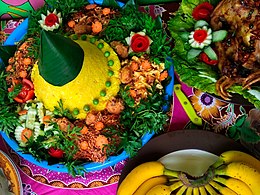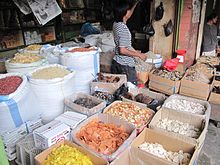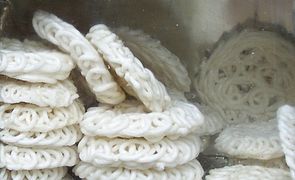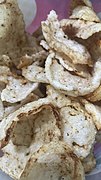Krupuk
 Kerupukin air-tight tin containers | |
| Alternative names | Kerupuk, keropok |
|---|---|
| Course | Snack |
| Place of origin | Indonesia[1][2] |
| Region or state | Java |
| Serving temperature | Room temperature |
| Main ingredients | Starch, animal proteins, vegetables. |
| Variations | Different variations according to ingredients |
 |
| This article is part of the series on |
| Indonesian cuisine Masakan Indonesia |
|---|
|
|
Krupuk(Javanese)[n 1]is acrackermade fromstarchor animal skin and other ingredients that serve as flavouring. Most krupuk aredeep fried,while some others aregrilledorhot sand fried.They are popularsnacksin maritimeSoutheast Asia(Indonesia,Singapore,Malaysia,Brunei,andPhilippines), most closely associated with theculinary traditions of Indonesia,in particularJavanese cuisine.It is a ubiquitous staple in its country of origin and has spread to other countries either via the migration of diaspora populations or exports.[3]
Etymology
[edit]KrupukinJavanesemeans "fried side dish" (made of flour, mixed with other ingredients).[4]The word was later absorbed into other languages and stylized according to local pronunciations. In Indonesia and the modern states ofBrunei,Malaysia,Thailand,Singapore,and thePhilippines,krupukis known under a general name with minor phonetic variations. It is called "kerupuk"in Indonesian, while in Malay, it is"keropok".In Dutch, it is"kroepoek"(" oe "being equivalent to" u "), which was also theoriginal spellingprior to the establishment of modern Indonesia and post-independencespelling reform.
The Javaneseonomatopoeiafor the sound of crunchy foods (kraukfor a big crunch;kriukfor a small crunch) is believed to have inspired the name. It might have also inspired the naming ofkripik,a different type of Javanese cracker.
History
[edit]According to culinary historian Fadly Rahman, krupuk had existed inJavasince the 9th or 10th century.[2]It was written in the Batu Pura Inscription askrupuk rambak,which refers to crackers made from cow orbuffaloskin, that still exist today askrupuk kulit( "skinkrupuk") and are usually used in aJavanese dishcalledkrechek.In its development, krupuk spread across thearchipelago,and the taste varies according to the ingredients. From Java, krupuk spread to various coastal areas ofKalimantan,Sumatra,to theMalay Peninsula.[2]It is produced and consumed in various varieties and is an integral part of the national cuisines of several Southeast Asian countries.Kroepoekalso can be found in theNetherlands,through theirhistoric colonial tieswith Indonesia.[5]
Today, krupuk has been one of the food-product export commodities of Indonesia, reaching foreign markets including Thailand, China, South Korea, the United States, Mexico, and the European Union.[3]
Preparation and consumption
[edit]To achieve maximum crunchiness, most of this pre-packed raw krupuk must be sun-dried first before being deep fried at home. To cook krupuk, a wok with plenty of high-temperature cooking oil is needed. A healthier, fatless version might be made by briefly pulsing the raw krupuk in the microwave oven: usually one minute at the medium (~700W) power is enough to successfully puff a handful of chips. Raw krupuk is quite small, hard, and darker in color than the cooked one.[6]
Krupuk and kripik can be consumed alone as a snack or cracked and garnished on top of foods for a complementary, crisp texture. CertainIndonesian dishessuch asgado-gado,karedok,rujak,asinan,bubur ayamand certain kinds ofsotorequire a certain type of krupuk for toppings. It is an essential ingredient to makeseblak,a savoury-spicy dish made of boiled, wetkrupukcooked with protein (chicken, beef, or seafood), all in a spicy sauce.[7]
Types
[edit]Indonesia
[edit]

Indonesia has perhaps the largest variety ofkrupuk.[8]There are many variations on krupuk, many of which are made from starch with seafood (shrimp, fish, or squid), but occasionally with rice, fruits, nuts or vegetables; these variations are more usual in Southeast Asia.

- Krupuk amplang,refers to pingpong ball-sized fish krupuk fromKalimantan.
- Krupuk bawang,garliccracker
- Krupuk blek(also known askrupuk uyel,krupuk kampung,orkrupuk putih), acassavastarch cracker ubiquitous in Indonesia
- Krupuk gendar(also known askrupuk puli,krupuk karak,krupuk beras,orkrupuk nasi), is Indonesian style groundrice crackercommon especially in Java island.[9]
- Krupuk ikan,fish cracker, commonly found in Indonesia, especially in seafood industry production centres such asPalembang,Bangka,CirebonandSidoarjo.Wahoois the most popular fish used to make krupuk ikan, however a more expensive variant uses belida fish or featherback knifefish.
- Krupuk kedelai,soybeankrupuk.
- Krupuk kemplang,a type of flat fish cracker that is particularly popular in the south Sumatran city of Palembang.
- Krupuk kuku macan,another name ofamplangwith distinct "tiger nail", nugget-shaped, brown-coloured fish cracker, popularly associated withSamarindaand the island of Bangka.
- Krupuk kulit,found in most parts of Indonesia,Krupuk jangek(Minangkabau), orRambak(Java); refer to crackers made of dried cattle skin, particularly popular in the Minangkabau area ofWest Sumatra.
- Krupuk kulit babi,crispy fried pork skin, also known aspork rinds.Rarely found in Muslim-majority regions in Indonesia, but common in non-Muslim majority provinces, such asBali,North Sumatra,andNorth Sulawesi.
- Krupuk kupang,krupuk made with a mixture ofkupangsmall clam (Potamocorbula fasciata) specialty of East Javanese fishing towns around Surabaya; Sidoarjo and Pasuruan.
- Krupuk melarat(poor man's cracker), created during difficult times in theCirebon Regency,more or less around the 1830's. It is not fried in vegetable oil, but roasted using river sand that has been cleaned beforehand.[10]
- Krupuk mie(noodlecracker), is a yellowish krupuk made from noodle-like paste usually used forasinantopping, particularly popular in Jakarta and most markets in Java.
- Krupuk petis(blackshrimp pasteorfish pastecracker), is a specialty cracker fromKendal Regency,Central Java.[11]
- Krupuk siput gonggong(dog conchcracker), a typical cracker fromTanjungpinang,Riau Islands.[12]
- Krupuk telur asin(salted egg cracker), is a cracker fromBrebes Regencywhich is well-known as the producer of salted duck eggs in Indonesia.[13]
- Krupuk udang,shrimp cracker orprawn crackerprobably is the most internationally well-known variant of krupuk. The examples of popularkrupuk udangbrands in Indonesia is Resep Kerupuk Udang,[14]Finna[15]and Komodo brand whereas the popular krupuk udang household brands in Malaysia are Rota Prawn Crackers and myReal Pulau Pangkor Prawn Crackers.[16]
-
Krupuk udang,prawn cracker
-
Krupuk ikan,fish cracker
-
Kerupuk kampungmade of tapioca starch
-
Krupuk amplang,fish cracker
-
Krupuk kemplang,fish cracker
-
Krupuk kupang,small clam cracker
-
Krupuk mie,noodle cracker
-
Krupuk kulit,skin cracker
-
Krupuk petis,black shrimp paste cracker
-
Krupuk melarat,cracker is roasted using sand
Malaysia
[edit]
In Malaysia, it is calledkeropokand associated with fish and seafood (those made with other foods than fish and seafood are calledkerepek). Varieties ofkeropokfound in MalaysiaKeropok kering,Keropoklekorand amplang.Keropok lekororiginated fromTerengganu,andAmplangis endemic to the coastal towns ofSempornaandTawauinSabah.Whilekeropok keringcan be found in most of the Malaysian states,[17]Mukah town inSarawakalso historically known as a fishing town for the making ofkeropok.[18]
Philippines
[edit]Krupuk,most commonly spelt askropekandkropeckin the Philippines, is sometimes also referred to as "fish crackers", "prawn crackers" or less commonly as "fishchicharrón",which is technically fried fish skin. Some forms of chicharrón are made with non-animal sources such astapiocastarch and greenpeas,hence the term. It is debatable if the vegetarian, kropek-like "mock pork crackling" could be considered a form ofkropek,since there are a lot of similarities but also differences which make them two. These are sold atsari-sari storesin smaller portions as a light snack, as well as in bigger bags at local supermarkets and convenience stores.

Kropekis often eaten as anappetizer,with a vinegar and chili dipping sauce, sometimes as accompaniment at drinking sessions, or paired with a meal. There are a lot of local brands which sell different varieties ofkropek.Some of the more well-known brands in the Philippines are La La Fish Crackers andOishiprawn crackers, fish crackers, and fishkropeck.Oishi, a Philippines-based company that has expanded across Asia, is one of the biggest Filipino and Asian companies.
Production centres
[edit]

In Indonesia, major production centres ofkrupukare usually coastal fishing towns.SidoarjoinEast Java,[19]CireboninWest Java,Karimun Jawaisland,Padang,PalembangandMedanin Sumatra,Bangka Island,SamarindaandPontianakin Kalimantan, andMakassarin Sulawesi are major producers of krupuk, and many recipes originate from there.
Some inland towns are also famous as krupuk production centres, such asBandung,GarutandMalang.Although they usually do not produce seafood-based krupuk as their coastal town counterparts. Most krupuk producers traditionally are modest home industries. However, today there is a dilemma among krupuk factories, whether to shift to automation through modern machinery but have to lay-off some of their workers, or continue producing in traditional ways but lack in producing capacity.[20]
Most of the coastal towns in Malaysia such asMukah,Malacca Town,Pangkor IslandandLumutproducekeropokfrom large scale manufacturing to small scale home factories.
See also
[edit]Notes
[edit]References
[edit]- ^Adrian Vickers(3 November 2005).A History of Modern Indonesia.Cambridge University Press. pp.190–.ISBN978-1-139-44761-4.
- ^abcWirayudha, Randy (31 August 2017)."Kriuk Sejarah Kerupuk".Historia - Majalah Sejarah Populer Pertama di Indonesia(in Indonesian).Retrieved11 October2020.
- ^ab"Indonesia sells 35 containers of kerupuk at Thaifex 2016".The Jakarta Post.Retrieved30 August2021.
- ^Poerwadarminta, WJS.Bausastra.
- ^"A Guide to Dutch Indonesian Cuisine".Awesome Amsterdam. Archived fromthe originalon 6 July 2014.Retrieved15 August2014.
- ^Indonesian Regional Food and Cookery: Prawn cracker
- ^Karina Armadani (19 December 2014)."Kuliner Tradisional: Menikmati Pedasnya Seblak Khas Bandung".CNN Indonesia(in Indonesian).
- ^"Aneka Kerupuk Indonesia".bangmuzh.26 March 2022.
- ^Aisyah, Yuharrani (23 November 2020)."Resep Kerupuk Gendar dari Nasi Sisa, Tanpa Garam Bleng dan Penyedap".KOMPAS.com(in Indonesian).Retrieved11 March2024.
- ^Izan, Khaerul."Kerupuk melarat kuliner khas Cirebon yang tercipta saat masa sulit".antaranews.com(in Indonesian).Retrieved7 May2023.
- ^"Krupuk Petis Udang".jatengprov.go.id(in Indonesian). Central Java Government.Retrieved7 May2023.
- ^"Kerupuk Siput Gonggong Khas Tanjungpinang".Kepritoday(in Indonesian). 24 July 2014.Retrieved8 October2023.
- ^"Kerupuk Telur Asin Brebes Laris Manis hingga Luar Negeri".kumparan.com(in Indonesian). PanturaPost.Retrieved8 May2023.
- ^"Resep Kerupuk Udang dan 6 Tips Cara Mudah Membuatnya yang Bikin Ketagihan | bangmuzh".26 March 2022.
- ^Krupuk Udang Finna
- ^"myReal Pulau Pangkor Prawn Crackers by Lumut Crackers Sdn. Bhd".lumutcrackers.com.my.
- ^Su-Lyn Tan; Mark Tay (2003).Malaysia & Singapore.Lonely Planet. pp.149–.ISBN978-1-74059-370-0.
- ^Pat Foh Chang (1999).Legends and history of Sarawak.Chang Pat Foh.ISBN978-983-9475-07-4.
- ^"Sidoarjo Cracker Industry".EastJava.com. 4 November 2010. Archived fromthe originalon 3 October 2015.Retrieved3 November2014.
- ^"Krupuk A bite-size problem".The Jakarta Post.Retrieved30 August2021.










